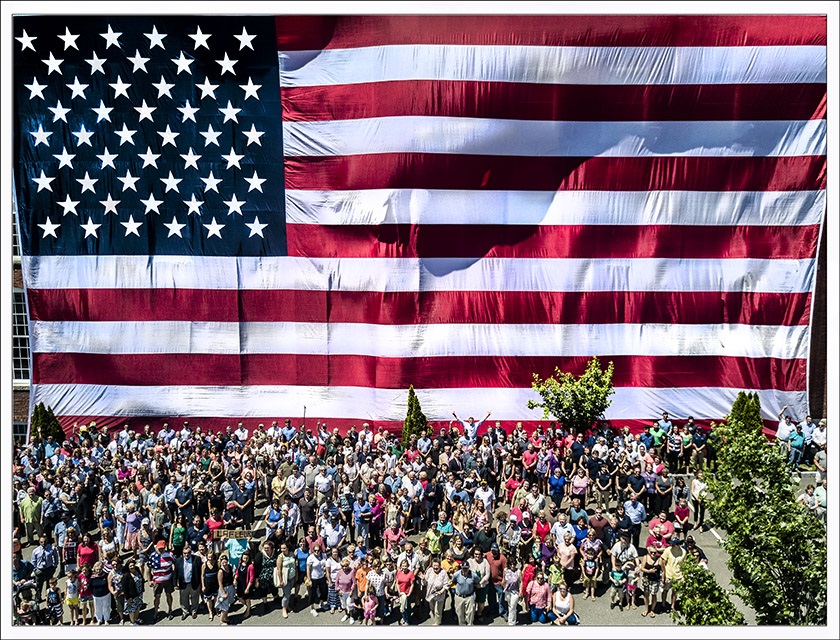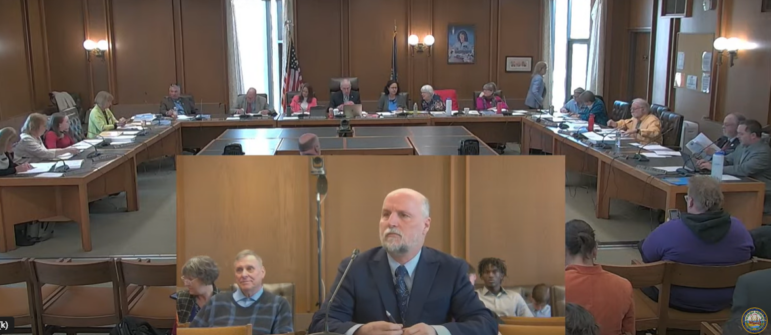Manchester’s Flag Day observance featured the unfurling of a 95 by 50 foot American Flag hung from the former Amoskeag Manufacturing Mill No. 11 on Manchester’s West Side.
The flag’s owner, Brady Sullivan Properties, invited residents to pose for a photo that replicates the original scene when the first “Great Flag” was unveiled in 1914 with the mill workers who created it posing in a similar manner. –— Bob LaPree, InDepthNH.org Photo Editor
Remarks By John Clayton,
Executive Director,
Manchester Historic Association
It is an honor to be here for the re-imagining of an iconic moment in Manchester history thanks to our friends from Brady Sullivan Properties, for it was in 1914 that mill workers from Amoskeag gathered to pose before what has become known as “The Great Flag.”
In fact, The Great Flag was first unfurled outside this building – Amoskeag Mill No. 11 – on June 29, 1914. Just to give you some historical context, that was the day after Archduke Ferdinand was assassinated in Sarajevo (which, incidentally, precipitated what was known back then as the Great War). The flag was 95 feet long and 50 feet high and it weighed in at 200 pounds.
It was created, quite simply, to promote the fact that Amoskeag was in the flag business. That end of the business got off the ground – so to speak – when the first flag produced by AMC was raised atop Mill No. 11 on Dec. 5, 1913.
Thanks in part to the new flag subsidiary, 1914 became the single greatest year of physical production in Amoskeag’s glorious history. It was almost a given, therefore, that Amoskeag would produce the greatest flag ever made.
There are those who still argue that claim, but I can cite the headline in the Amoskeag Bulletin of July 1, 1914 that proclaimed: “BANNER IS COMPLETED; Amoskeag Company Makes Largest Flag in the World.”
The story had more statistics than a 20-inning baseball game.
Readers discovered the flag would require a 285-foot pole for proper display. Each of the 13 stripes was 47 inches wide and each of the 48 stars — don’t forget, it was 1914 — measured three feet across. The accumulation of stars contributed nine pounds to the 200-pound banner, which the unnamed reporter described as “the grandest sight upon which American eyes ever rested.”
In keeping with Federal mandate, no portion of the flag was allowed to touch the ground during manufacture. Thus, the giant banner was “Amoskeag spun, Amoskeag woven, Amoskeag dyed and Amoskeag constructed — an All-American flag !”
Of course, this might all be the stuff of legend if not for Harlan A. Marshall, a “colorist” at Amoskeag who doubled as chairman of the Textile Club’s camera section. When it was decided that the flag would be displayed here for all to see, it was Harlan who arranged to photograph the event.
The mammoth display was coordinated by a gentleman named Perry Dow. You might say he was the Scott Aubertin of his day.
“Two strips of board were clamped to the upper edge of the flag,” according to the Bulletin, “and it was raised by means of two ropes from each window of the top floor. Its weight was about 375 pounds, including the apparatus for hoisting.”
When it was in place, the flag covered 36 windows of the western facade of the No. 11 Mill, and… while some Amoskeag employees peered from windows, 128 of the workers who created it gathered beneath the flag for Harlan Marshall. We have that image on display at the Millyard Museum, and not a week goes by when some visitor doesn’t call me over and point out his or her grandmother or grandfather in the photo.
Ultimately, Harlan Marshall became curator of the Manchester Historic Association, and among the many treasures in our collection?
His original glass-plate negative. It is the single most reproduced photo in our collection.
The image he captured has been used in countless national ad campaigns. Time-Life used it as a two-page spread in a publication called “This Fabulous Century.” It was used as cover art for an issue of Anton Dvorak’s “New World Symphony.” It was in the title sequence for the PBS series “The American Experience,” and let us not overlook appearances in magazines like Forbes, Yankee and National Geographic.
For all we know, the photo has outlived the Great Flag itself.
Shortly after the photograph was taken, the banner was bundled up and shipped by train to Chicago. It came to be owned by Marshall Field & Co., a large department store. Marshall Field eventually loaned it back to Amoskeag in 1916 for the Citizens’ Preparedness Parade in New York City. The massive banner was carried through the streets by 70 men, who were trailed in the equally massive 11-hour procession by marchers from Amoskeag ‘s New York sales office.
And where did it go from there? A few years ago, I tried to track it down.
I reached out to Marshall Field & Co. in Chicago. I spoke with the archivist/historian for the store – a gentleman named Tony Jahn – and this is what he told me:
“I know in 1950, Marshall Field had a flag in the light-well at the store – a 14-story atrium space – and that flag was listed as 100×50 feet,” he said. “That’s pretty close to the dimensions of your flag. Maybe it was that same flag. I just don’t have any documentation to confirm that.”
He said, “If I had to guess, I would guess that when Alaska and Hawaii became states (in 1959), the flag would have been disposed of in the proper fashion. I’m sure they would have adhered very strictly to the rules governing that process.”
So in the end, we still don’t know what became of the original Great Flag… but what matters today – fittingly enough on Flag Day – we gather to celebrate a symbolic moment in our city’s history… a moment centered around Old Glory… the greatest symbol of all.





